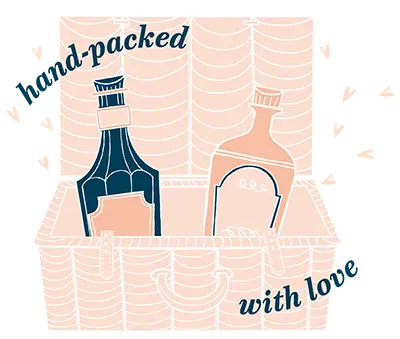There are hundreds of little techniques in the process from field to glass that can change the style and flavour of a beer quite dramatically. When talking about beer, it can be hard to pinpoint what makes it taste so great, and how to find more beer that’s just as delicious.
Here we’ll cover a little, and sometimes quite a lot, of the ins and outs of what makes your pint so great. Read through our ingredients guide for the breakdown of the essential components that go into your pint, and how their variations can affect the final taste of what's in your glass. We’ve also broken down the whole process of making a beer so you can read up on all the different ways brewers tweak the recipe to create unique and delicious brews in a whole range of styles.
Contents:
- Glossary
- Tasting Guide
- Ingredients:
Hops, Malts, Yeast, Water
- Brewing Styles (and how its made):
Malting, Mashing, Lautering, Boiling, Fermenting, Conditioning, Filtering
- Storage:
Keg, Cask, Can, Bottle, Cellaring Your Own Beer
- Beer Styles :
The British Classics, Lager, Pilsner, IPAs, Saison, Sour, Wheat Beers, Eisbock

Glossary
Alpha acid- an
active component of a hop that contributes to bitterness
Aroma hop - hops best added later, to imbue aroma and more floral notes to beer
Base malts- grains that have been heated but not roasted, and form the primary base’ of the malt selection.
Beta acid- an active
component of a hop that contributes to aroma
Bine- the technical name for a hop vine
Bittering hop - hops best added earlier, for bitterness
Cellaring- the process of preserving and storing beers.
Esters- a type of chemical compound made in the brewing process. Different brewing processes will produce different esters. Esters usually impart a fruity (or sometimes undesirable) flavour.
Grain bill- the combination of grains that will be used in the brewing process
IBU- international bittering units, an international scale developed to judge the bitterness of a beer
Liquor- water used in brewing
Malts- the grains that are used as the basis of a beer
Mash tun - A large metal container for boiling the wort
Skunked- light damage to beer leaving skunky aroma.
Wort- the mixture of ingredients that will transform into the beer, before it has undergone fermentation.
Back To Top

Tasting guide
Unlike wine, there isn’t really any formal rules established for describing how beer tastes, so tasting notes for beer tend to refer a lot more directly to what they mean. For example;
Citrus - often used to describe very heavily hopped IPAs, literally refers to the beer smelling and tasting a bit like citrus fruits such as orange, grapefruit. Lime or lemon.
Dank- this one is a bit weirder; describes an intense, almost sticky, hop smell that’s deep and pungent - and noticeable from a good few feet away. Dank beer smells most directly like the fresh, unadulterated hop resin- often found in beers made with wet, fresh & unprocessed hops.
Grassy - the beer smells very fresh, and a bit like freshly cut grass and green leaves. This is nice as smaller note in a big juicy ipa, but without other powerful flavours to accompany it, this taste isn’t as pleasant. Grassy is also sometimes used to convey that the beer smells a bit like dried grass or hay- this second one is more often used to describe a bottom fermented beer, such as a lager, or as a criticism to beers that have been dry hopped a bit too long.
Piney- refers to the smell of pine trees. Like grassy, this is another word that cuts a fine line between compliment and critique. Lovers of big, bold IPAs seek out the piney flavour, but if out of balance, an overly piney beer can seem a tad too medicinal.
Other commonly used words include; Banana, Biscuit, Caramel, Clove, Earthy, Floral, Grapefruit, Juicy, Lemony, Spicy, Toffee
Back To Top

Ingredients
The 4 cornerstones of brewing are malt, hops, yeast and water. Variations to each of these elements are the basis of all the thousands of beer types we know and love.
Germany is perhaps the most famously reserved country when it comes to beer purity. Late medieval Germany saw the rise of Reinheitsgebot (don't worry, we won't ask you to pronounce it!) Often translated as the ‘German beer purity law,’ these laws listed malts, hops and water as the sole allowed ingredients (they didn't know about the role of yeast yet.) The goal was to restrict beer production to barley, leaving more wheat and rye for the bakers, and to outlaw beer ingredients such as belladonna and wormwood that were used in pagan religious ceremonies. The most famous version of this law was adopted in 1516 Bavaria, and it remained legally binding in Germany until 1987. To this day, many brewers across the world still comply with Reinheitsgebot.
Country by country, and brewery by brewery, folks have different attitudes to how far you can stray from these central elements; some beer brewers like to stick to just these traditional four elements, and some like to go off the deep end. Beer can be made with a huge variety of ingredients, with salt and spices, fresh fruits and even weird and wacky ingredients like cuttlefish ink and pizza. Read through our guide to ingredients, or hop through the sections with this mini contents:
Hops
Hops are used for both preserving beer and flavouring. The two most active components of a hop in flavouring beer are the alpha acids, and the beta acids.
Alpha acids contribute to the bitterness in beer. During the boil, they are transformed and increase the IBU of your beer. These oxidise over time, which is why IPAs become less potent with age.
Beta acids contribute to aroma. These are stable during the brewing process- especially the boil, they do however change gradually over time to become more bitter. This must be considered for the bottling and storing process- especially when producing cellaring beers. Beta acids can be used to balance the transformation of alpha acids; meaning the beer remains bitter with age- but the character of this bitterness will vary.
Hops are used as either a bittering hop, an aroma hop, or as a dual-purpose hop depending on their balance of alpha and beta acids. Across the world, there are hundreds of hop strains developed to satisfy a whole host of flavours. Here, we’ll run through the most popular hop strains used today.
The English Aroma Hops
Classic British hops tend to have lower levels of alpha acids, making them more delicate and aromatic. Britsih hops are often earthy, and slightly spicy- making them ideal partners for malt flavours and lower abv session beers. Of all the hop varieties grown in the UK, but Fuggles and Goldings are probably the most celebrated, each with a long history in the region
Fuggles
Originally used as a dual purpose hop it is now primarily used for aroma. Commercialised by Richard Fuggle in 1875, it is a very well established hop in the British flavour palate. Mild, woody and slightly floral it is ideal for porters, milds and bitters.
Goldings
Goldings is the name given to a closely related family of hop strains that have been growing in Kent as far back as 1790. The East Kent Goldings variety is the only hop to have a protected designation of origin. Goldings hops are famously smooth, with a sweet bitter taste and lightly bitter finish. This versatile flavour profile means that they are used in a huge range of traditional British beer styles- from pale ales, blondes and bitters, to dark stouts and porters.
Brewers gold
While rarely used in modern brewing, this big, bold and juicy hop from along the Wye in Kent has a special place in British hop history as the ancestor of many super alpha hops such as Centennial, Citra and Nugget.
[caption id="attachment_2381" align="alignnone" width="4000"]
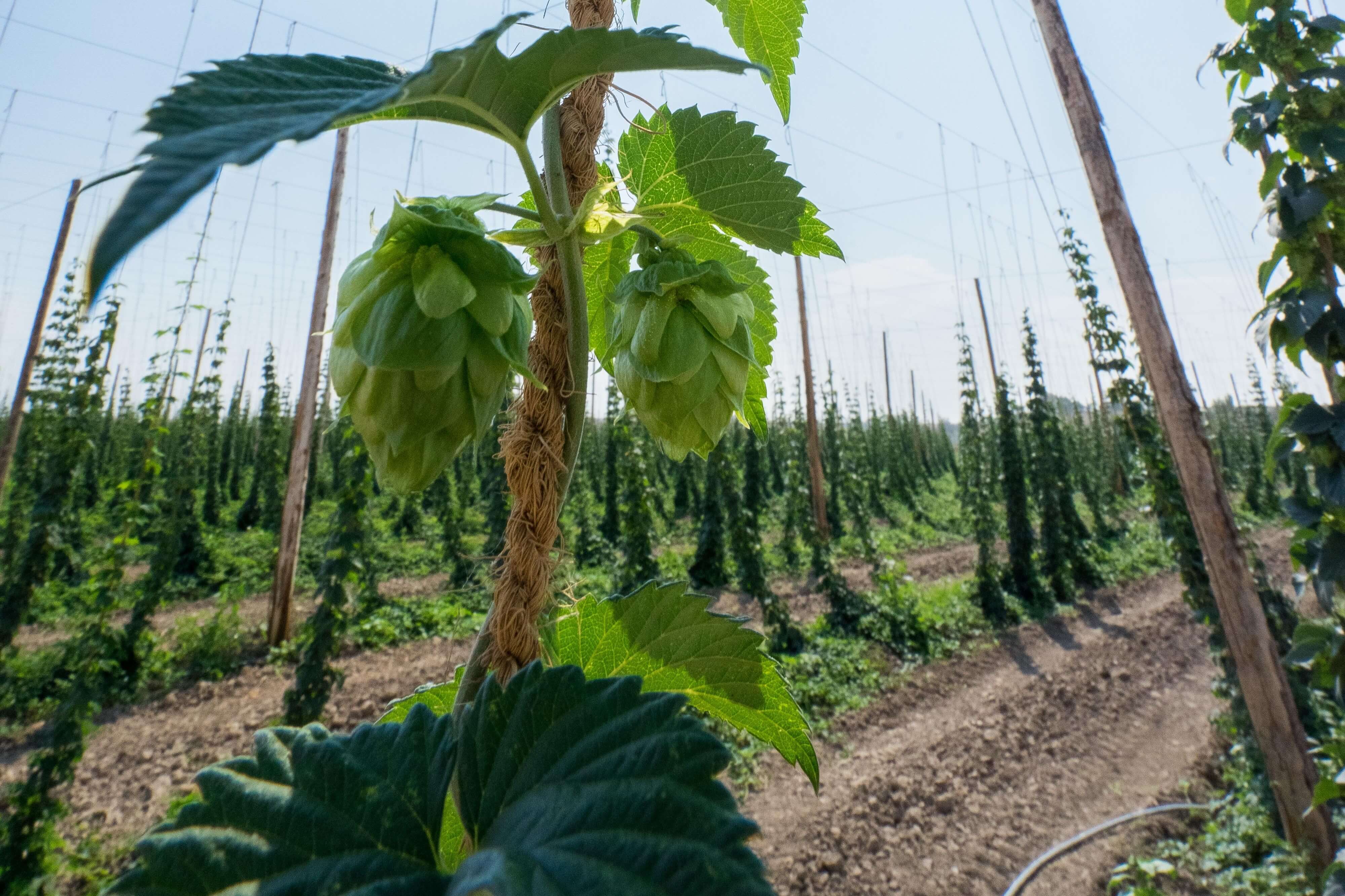
Hop bines growing vertically up the frame[/caption]
Noble Hops
These European hops are lauded for low bitterness, high aroma and complex, subtle notes of spice. Noble hops tend to have more essential oils in them, with a lower alpha acid content. They have a more complex, but not overly bitter flavour. While each of the four hop breeds in this category, Hallertauer, Tettnanger, Spalt, and Saaz have a long history, the term ‘noble hops’ only got traction with renewed interest in craft brewing in the 1980s. These hops are deeply associated with terroir and are also some of the priciest hops about.
Hallertau
Also known as Hallertauer Mittelfrüh. This Bavarian hop forms the backbone of the classic German lager flavour, with subtle floral and spicy notes.
Tettnanger
This Bavarian hop is perfect for lagers and wheat beers. It is a much hardier hop for growing, with a very subtle flavour. An all-purpose hop!
Spalt
Another Bavarian hop, Spalt has a woody, peppery and sometimes banana taste that’s perfect for pilsners and lagers. The city of Spalt has been growing hops since the 8th century and the Spalt hop was the first-ever hop to be granted the German Hop Seal.
Saaz
Czech hops with a distinctive red bine, and a warm cinnamon and earthy herbal flavour- with just a touch of citrus. Famously used in Pilsner Urquell, Saaz defines the taste of Czech lagers and works perfectly in Belgian ales. Genetic research has found that Tettnanger, Spalt and Saaz hops share such genetic similarities that they likely belong to a Saazer common ancestor.
[caption id="attachment_2382" align="aligncenter" width="800"]

A sea of hops ready to be processed into beer[/caption]
New World Hops
Where the English and Noble hops deal in delicacy and restraint, new world hops push all that out the window. Bold juicy new world flavours have been foundational to forming the craft beer movement. New world hops are all about experimental strains that have pushed the boundaries of beer flavour profiles.
Cascade
One of the ‘Three Cs hops’ that many tote as the states answer to noble hops (alongside Centennial and Columbus). This citrusy, floral and very grapefruit heavy hop is behind the trademark taste a Sierra Nevada Pale Ale.
Chinook
A piney, spicy and robustly grapefruity hop, many consider it a fourth addition to the roster of noted US ‘C’ hops. The balance between citrus and pine makes Chinook hops not only perfect for IPAs, but an intriguing addition to barley wines and winter warmers.
Citra
A classic American hop. One of the most sought after hops for its intense, juicy citrus punch
Amarillo
Similar to cascade but far more intense, this hop was actually discovered as a small hop bine growing alongside some Liberty hops in Washington.
Nelson Sauvin
A New Zealand hop named for its similarity in taste to the sauvignon blanc wine grape. A favourite among craft brewers, it is smooth yet bitter with incredibly rich gooseberry and white wine flavours- you might have tried it in a Punk IPA.
Motueka
This New Zealand hop is a Saaz descendant perfect in lagers, pilsners and belgians. Motueka amps up the citrus, with lemon, lime and tropical fruit flavours, but retains a very balanced bitterness.
Sorachi Ace
A Japanese hop strain with a flavour profile almost impossible to describe. Began in the 70s as a cross breed of British Brewer’s Gold and Czech Saaz, it tastes somewhere between lemon, lemon curd and dill- with an oaky, sometimes cedar background. The most unusual tasting hop there is- no wonder it took the 2007 hop shortage to bring this unique breed to international recognition, with Brooklyn Brewery’s groundbreaking Sorachi Ace Saison.
Malts
This is most commonly malted barley, however, to make a beer you only need a starch source which can then break down into sugars to ferment. The colour of a beer almost always comes from the malts used in the brew, and while often overlooked the choice and treatment of malts makes a huge impact. Before grains are used in the brewing process, they are ‘malted,’ and can often then be roasted too.
Roasting malts adds caramel, toast, biscuit, chocolate or nutty flavours to your brew- depending on how you do it. A light roast will give you a light beer, a medium roast will give you a sweeter, amber beer and a dark roast will produce a dark beer. Because they don’t add much to fermentation, many brewers include unmalted roasted grains to the wort too.
Many beers combine a variety of starches together to draw upon the grains respective strengths- this is what is called the ‘grain bill.’ Here we run through the most commonly used starches used as malt:
Barley
By far the most commonly used malt in brewing beer. Barley is relatively low in gluten, and stocks plenty of has enzymes to turn to the starches into fermentable sugars.
Wheat
Wheat, unlike other cereals, lacks the enzymes that can convert unfermentable starches into fermentable sugars. Because of this, brewers tend to use at least 30% non-wheat in the mash to kick start the fermentation. Wheat beers are often thicker because so much unfermented starch make sit through to the final product.
Rye
Imparts a distinct, crisp yet spicy flavour. However, during the brewing process rye clumps together making a hugely viscous wort. Rye beers are usually only 10-20% actual rye, with the rest of the malt profile left to barley.
Oats
Add a creamy, silky mouthfeel. Oats also improve the stability of a brew and are commonly found in big dark beers such as stout.
Sorghum
The gluten-free grain! Notably tricky to brew with, meaning most brewers add a sorghum syrup instead.
Corn
A less common grain, though traditional in the Andes, it is also used in the famous Italian beer Peroni, as well as their Nastro Azzuro.
[caption id="attachment_2378" align="alignnone" width="2784"]
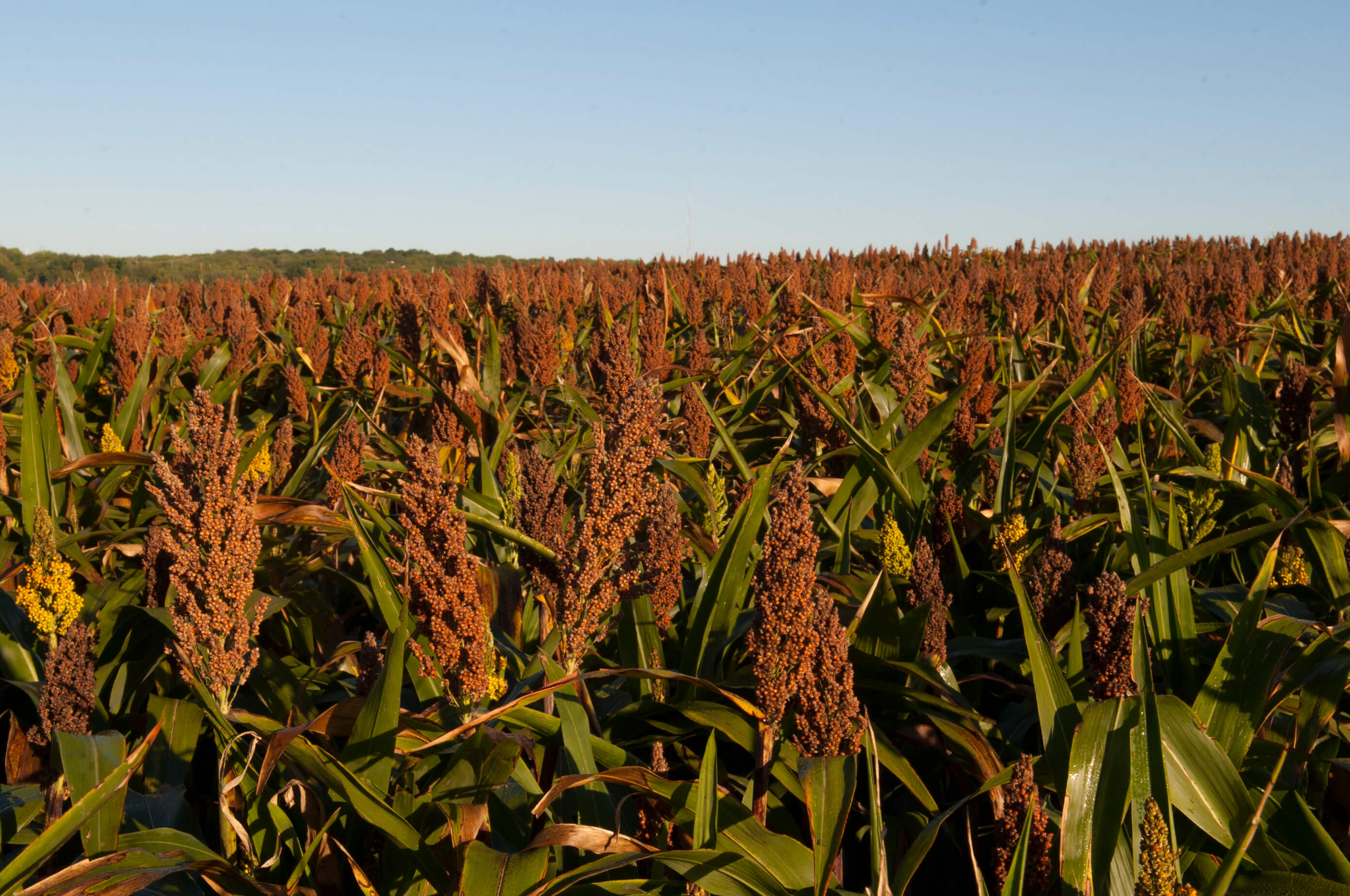
Sorghum growing in the field[/caption]
Yeast
Yeast is what causes all the delicious magic in beer- its the smallest part that makes the biggest change by transforming the fermentable sugars into alcohol. There are hundreds of different yeast strains used in brewing, each imparting a unique flavour. There are a few major categories yeasts fall into though, such as;
Top-fermenting yeast
This is ale yeast. It ferments better in ambient temperatures, between 10 and 25 °C, and much like its name will rise to the surface of the brew during fermentation. Warmer brewing temperatures means higher levels of esters in the final beer.
Bottom fermenting yeast
This is your lager yeasts. They ferment in cooler temperatures, from 7 to 15 °C and will gradually sink to the bottom of the brew during fermentation. The colder temperature means a slower fermentation process.
Spontaneous fermentation
A classically Belgian method of fermenting beer. The beer is exposed to the surrounding open air to allow natural and wild yeast to infect it. This produces sour beers, which are traditionally also unfiltered. Regional differences in wild yeast strains will produce different flavours of beer, so many traditional beers in this style are hyper-regional.
Champagne yeast
Champagne yeast is rarely used in beer but can be brought in to achieve higher ABVs or more intensely sour finishes that a brewers yeast couldn't handle. It also produces smaller, more numerous bubbles which allow for the release of flavours in the glass and imparts a dry finish with very little change to the beer’s flavour. Champagne yeast is most often used in secondary fermentation.
Water
The element of beer with perhaps the most mythos and superstition attached to it. Water affects beer in three main ways. Most obviously, chlorine or contaminants will cause off flavours in the beer, so water purity is essential.
The PH of the water going in will also affect the PH of the final beer. Ph will change what flavours will be tasted in the final beer, bringing some to the front and others to the back. A lower ph will give you a crisp and lively beer, with higher PHs dulling flavour perception. A sour beer will have a very low ph clocking in at around 3.0.
Water also contains different minerals that can change the beer, perhaps the most famous being the gypsum found in Burton water, which makes it ideal for brewing hoppier pale ales. Many brewers will replicate this by ‘burtoninsing’ their water and adding in gypsum. The level of minerals in water is what causes ‘hard’ and ‘soft’ water, with soft water having lower levels.
The water available in certain areas has made them famous for distinct beer styles. Dublin has very hard water which has made it famous for dark stouts like Guinness. At the other end of the scale the soft water of Plzeň in the Czech Republic has made it famous for pilsners.
Back To Top

Brewing Styles
Across different brewing styles, the process of brewing beer fairly consistently follows these 7 stages:
MALTING
The first stage in making beer involves transforming the grains into malts, and has 3 phases: The grains are soaked in water, allowed to germinate, and then heated to stop the germination process.
As grains enter the brewery, brewers will perform a series of quality checks to make sure they are in the perfect condition to be malted. This includes passing the grain through a range of sieves and destoners to remove foreign matter, as well as passing strong magnets over the grain to remove any metals. They will also check their moisture content and dry them if necessary, test for fungus and bacteria, and test the water sensitivity of the grains.
Once everything is in order, the malting can begin. First, the barley is steeped in a huge vat with water for around 40 hours. It’s then spread out on the floor of a specially built germination room and turned regularly - you might have seen old pictures of brewers shovelling or tilling the malt in a malt house to turn it. This keeps the airflow even throughout the grains and stops them from sticking together.
After 4-6 days of germination, the grains are kilned- they’re heated to stop the germination process and dry them out. This means that the grains have begun to transform just enough to activate the enzymes that will allow them to transform the starch into sugars, but the heating process has denatured (deactivated) the enzymes that will make the grain grow into a plant.
After kilning the grains are cleaned up in the ‘deculming’ process; which removes any little roots that the grains have sprouted during germination.
During the kilning process, though sometimes after too, the grains will be roasted. Grains that have been heated, but not roasted, are known as base malts. These usually form the basis of the wort, they will break down in this early brew to produce the fermentables. Roasted malts are used to add extra depth and flavour, and contribute far less to the fermentation.
The process of roasting malts also stops the enzymes that break starch down into sugar. This means that the darker you take your roast, the less material you leave in the grain that can transform into sugar. More of the starch in a roasted malt will stay in the beer unfermented, which is why darker brews are thicker and have a heavier mouthfeel. As more of these transformative enzymes are denatured, the beer will have a longer, more stable shelf life too.
[caption id="attachment_2389" align="alignnone" width="1920"]
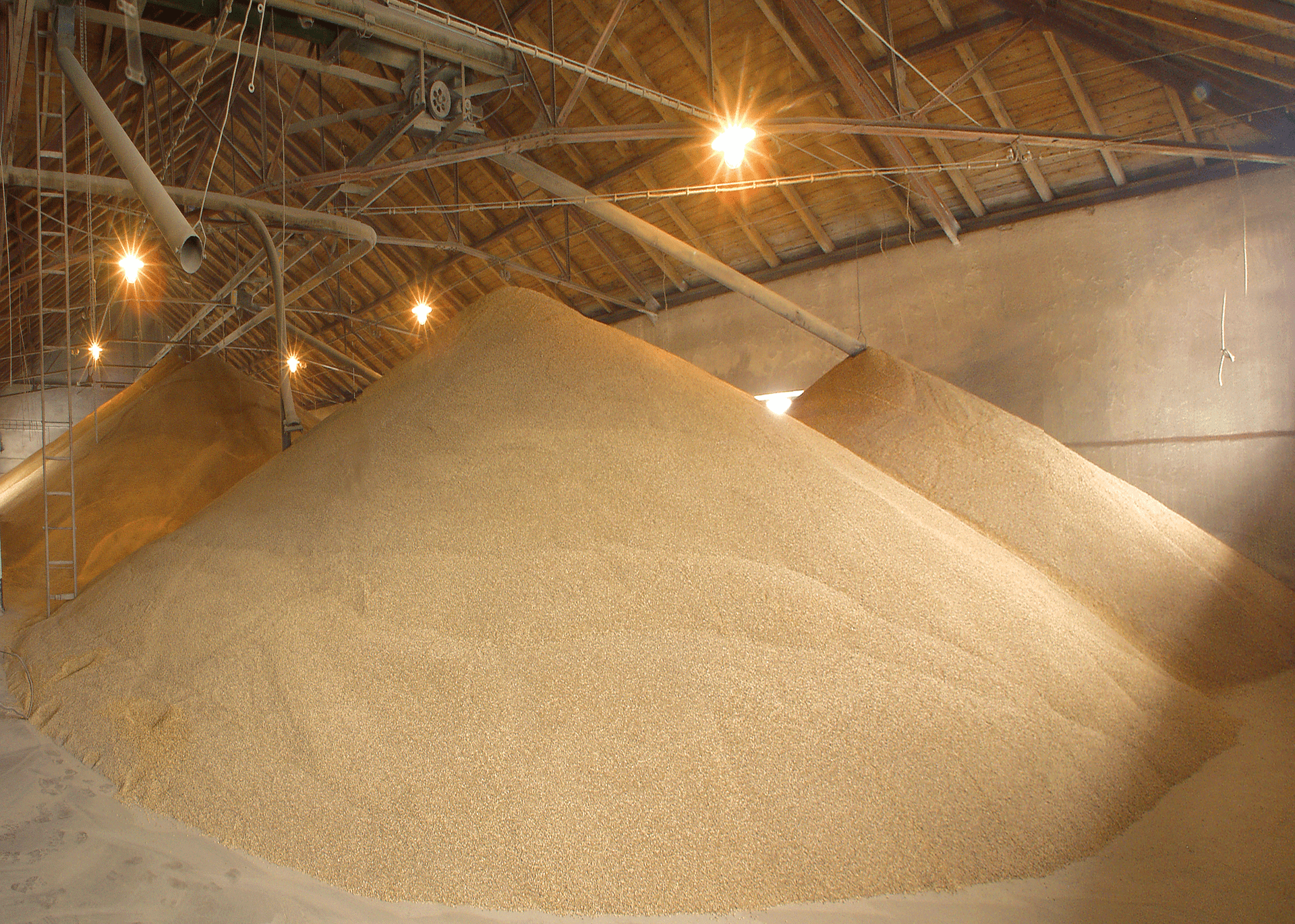
Huge amounts of malts are moved around the brewery in the malting process[/caption]
MASHING
Here the water that will be used in the beer (the liquor) is combined with the grain bill and boiled. As they boil together, the ‘wort’ is produced- the grains break down and release their sugars and proteins into the water producing a sweet, malty liquid that will ferment into beer.
Different elements require temperatures to be broken down, so the boiling process involves heating to various temperatures and then resting there for a period of time before moving up to the next temperature.
The first of these rests is usually for 10- 25 minutes at 45-50°C, where enzymes work on the proteins and starch. A protein-rich grain bill, such as wheat, will pause longer at this stage. Then the mash is heated to 62-72°C for the fermentable sugars to be broken down. A lower temperature at this stage will produce more fermentable sugar and less unfermentable sugars- making will produce a drier beer with higher alcohol content. Conversely, a higher temperature will produce a sweeter beer with lower alcohol content.
Mashing is done either through infusion mashing or decoction mashing. Infusion mashing
Infusion mashing is the most common form, where (very simply) all the ingredients are placed in one big mash tun for the entire heating process. Mash tuns are large enclosed pots of varying widths, and usually about 2 metres deep. They can be made of steel or copper and are often insulated with wood, or more modern alternatives.
An older and more intensive method of achieving these temperature rests and hikes is decoction mashing. Here, a part of the mash is taken away and boiled in a separate vessel and then reintroduced to the rest. This reintroduction raises the overall mash temperature. This process is done one to three ties, depending on the brewer. Intensively boiling one part also increases the physical pulping of those grains, which brewers argue adds to the depth of malt flavour.
LAUTERING
This is the process of separating the mash into the clear wort and the leftover grains. It involves the stages; mash out, recirculation and sparging.
The first step is a final hike in temperature called the ‘mash out,’ which involves temperatures of o 75-77°C. This is to stop the enzymes from carrying on transforming the wort by deactivating them. Mash tuns have a false bottom so that after the boiling process the wort can be drained off the bottom and poured back over the mix during recirculation. The final step is sparging. Hot water is run over the leftover mash to make sure all soluble material is collected from the grains.
BOILING
In this stage, the wort that was produced by mashing and lautering is boiled with hops and any other flavour elements. Beer is put on a continuous, even ‘rolling boil’ for 45-90 minutes inside a brew kettle, and then is filtered again to remove the hop matter.
A hopback is a chamber full of whole hops that the hopped wort is passed through as it moves from the boiling brew kettle to the wort chiller. The whole hops act as a sieve to remove excess debris from the wort. Many beers are passed through a hopback after the boiling process to add extra hop aroma. As the hops are not boiled, only beta acids are released in this process.
[caption id="attachment_2384" align="alignnone" width="4982"]
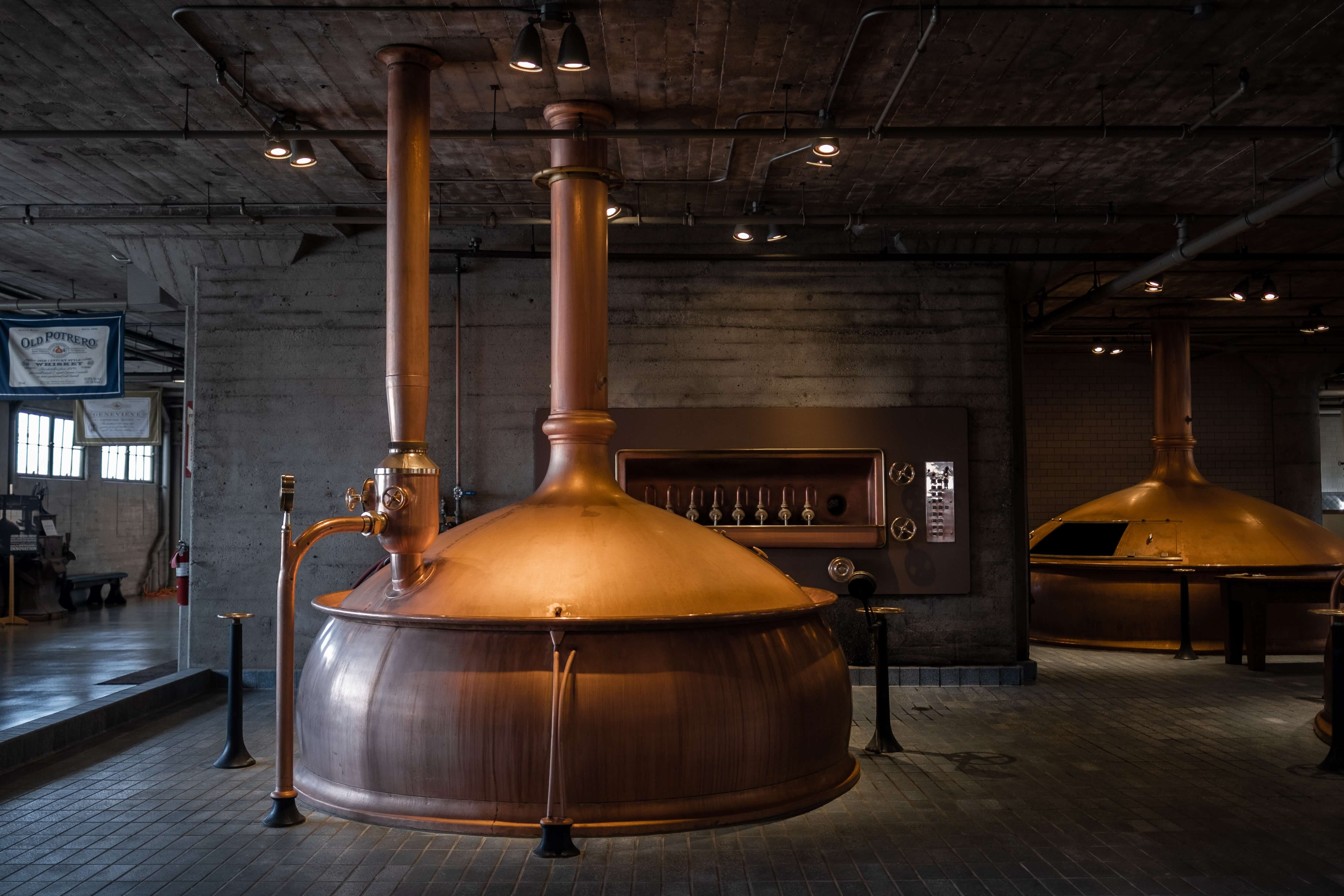
"In-ground" copper brew kettle[/caption]
FERMENTING
Once the wort is cooled to 20-26°C yeast can be added to prompt the primary fermentation. This is the process that turns the sugars into alcohol and carbon dioxide, transforming wort into beer.
Yeast strains are often classified as top fermented or bottom fermented, though in actuality there is very little biological difference between the two. Many beers also use hybrid strains of yeast to produce a distinctive flavour.
These yeast strains are then used in the three main fermentation types; warm, cool and wild or spontaneous. Warm and cool fermentation can take place in open or closed fermentation tanks. Spontaneously fermented beers are inoculated in large exposed ‘coolship,’ and fermented in wooden barrels.
CONDITIONING
This is the process by which the beer is aged to develop flavours, and will have a secondary fermentation. The secondary fermentation is primarily responsible for the level of carbonation in a beer. During the primary fermentation the CO2 produced in the fermentation process is usually allowed to escape. By contrast, conditioning is done in airtight containers, which means that as the carbon is released, the pressure of the container forces the carbon back into the beer. This is done in barrels, metal tanks, cask or bottles- each to achieve slightly different effects.
Many breweries accelerate this process in ‘forced carbonation,’ which is very simply forcing CO2 into a pressurized tank with the beer, until it dissolves in the beer. This allows bottling or canning to occur with a high consistency in the level of carbonation. It is also ideal for mass production, as the beer will not continue to develop carbonation in the bottles or cans after this process and can be quickly shipped out.
Bottle and cask conditioned beers will have extra yeast and sugar added, which will develop in the container before they are ultimately drunk. Whilst bottled beers need no intervention, casks will need a little help from the cellarman.
Once the beer is settled in the pub, it will be tapped and vented to allow air back into the cask, which will kick start the final fermentation. The cellarman will adjust the conditioning process to adapt the beer to regional tastes.
Despite common misconceptions, kegged beer can also be conditioned. As the quality of cask conditioned beer depends on having a highly skilled cellarmen on site, many brewers prefer to keg condition their ale to ensure that the quality remains consistent from pub to pub. With the development of keg conditioned beer, the primary differences between keg and cask is the dispense method used and the final serving temperature.
[caption id="attachment_2392" align="alignnone" width="800"]

Brewer checks the level of conditioning[/caption]
FILTERING
This is an optional final stage in the brewing process. Filtering the beer can give it a crisper, cleaner taste, and will aid a brighter, clearer looking beer. Filtering stops the conditioning process, meaning that the beer’s taste will remain largely stable. Because of this, filtered beer is also known as ‘brewery conditioned’ in the UK
Beer can be filtered physically, through cold filtering or with the aid of ‘finings’- something that is added to the beer to aid in the filtering.
Beer that is physically filtered by being passed through filter frames can have some remaining sediment, though filtering frames have become incredibly advanced so this is not a rule of thumb.
Cold filtering involves chilling the beer down so that protein molecules clump together, and can be easily filtered out of the beer.
Finings that are commonly used in beer include; Irish Moss, gelatin, isinglass and clay. These are added either at the end of the boil or during the fermentation process. They work by attracting the proteins to them, creating clumps that can be easily filtering out.
Back To Top

Storage
The way a beer is stored largely depends on the kind of conditioning you want to achieve.
Keg
Keg beer is most essentially beer that is dispensed using gas pressure. The pressurised gas keeps the beer cooler, so that even if a kegged and casked beer were kept next to each other, the kegged beer would dispense colder.
Many people argue that cold beer inhibits your ability to taste it, and whilst it is true that the cold inhibits taste keg dispensed beers are made to be served at these temperatures. They will either have big, bold flavours- like juicy IPAs or very dark stouts or be cold fermented like a lager.
Kegs have a bad reputation as in the past, many publicans were under pressure by big brewers to dispense low quality, bland keg beers. With the advent of the craft beer movement, however, brewers have learnt to brew to kegs strengths.
Cask
A cask beer will taste differently depending on a huge variety of factors such as; the local tastes of drinkers, the personal taste of the person in charge of the seller, the rate at which it sells, the quality of the line its drawn through, the amount of time its been on sale and the amount of beer that’s left in the cask.
As the cask isn’t pressurized, the more that gets drunk means the more space there is for air to enter and react with the beer. As such, all 72 pints in a cask of ale have to be drunk in 2-3 days for a pale beer, and maybe up to a week for a strong, dark beer. This means that to sell quality cask ale, a bar will need to restrict its range to avoid wastage. It also means that bars will be more reluctant to buy an experimental beer in a cask, because they can't guarantee it will sell fast enough.
This adds a special element to drinking cask, as the hyper-local conditions make such a big impact on the flavour of your pint, and you can literally taste local preferences in your glass. This also makes it far more unpredictable and time intensive to work with than kegs.
Can
Oskar Blues got rid of glass bottles in 2002 in favour of cans and they've been picking up steam since. Many breweries are even offering ‘Crowlers,’ which are 32 oz growler sized beers in cans (don't worry, it's nothing like a Watney’s Party 7.)
Aluminium cans are increasingly popular in craft beer as they keep out light, which prevents a beer from becoming ‘skunked’ - this is where the UV rays in sunlight break down the hop acids and reformulate them in a sulfur-smelling compound. The beer literally begins to smell like a skunk.
Beers in clear or green bottles are most vulnerable to skunking, and brown bottles are the most effective at keeping out UV. Cans, however, keep out all light and so are the safest bet for hop- laden IPAs. Aluminium also comes with green credentials as it is lighter to ship, and more likely to be recycled after use.
[caption id="attachment_2386" align="alignnone" width="7771"]
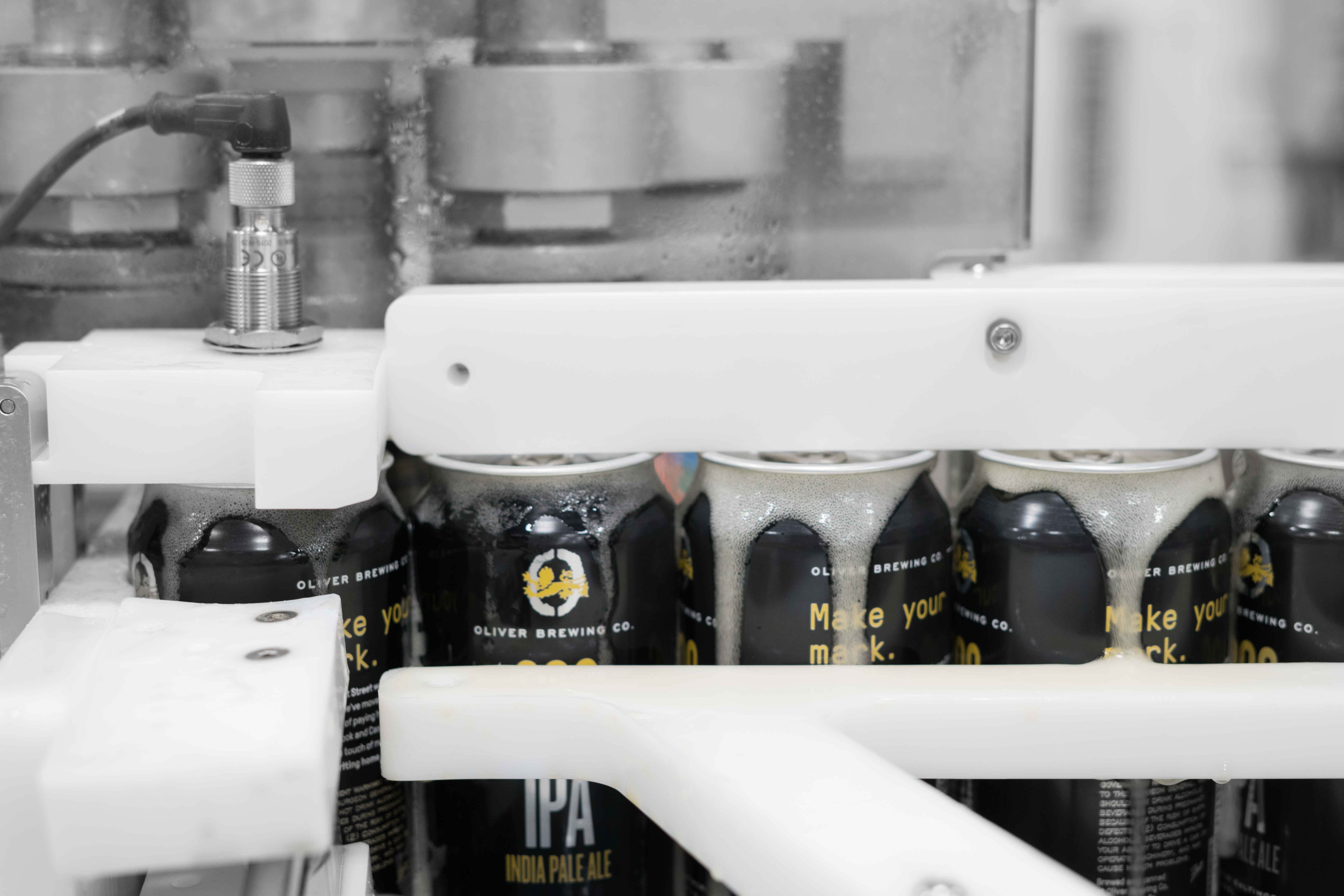
Craft IPA getting poured into cans[/caption]
Bottle
Bottled beer can stay colder longer than a canned counterpart, and bottled beer can be corked. Cork allows for easier ageing and bottle conditioning, as both the cork and glass can withstand higher pressure.
However, when it comes to the differences between bottles and modern can technology, the only true advantage to bottles is the addition they make to the aesthetic experience. Beers have been drunk in bottles for hundreds of years, and the old world appeal is undeniable.
Cellaring Your Own Beer
This is the process of ageing beer, much like you would a wine. Many more people are choosing to age beers to bring out the distinct, syrupy flavour mutations that ageing produces. Some beers can get more sour, others more mellow. As a rule, the malt flavours increase and the taste of alcohol and the carbonation will drop off.
If you want to try ageing your beer, keep it upright, in a cool dark place where the bottles won't be moved. Beer can age from between 6 months and two years usually - although Belgian beers and barleywines are often aged for years at a time.
Back To Top
People from across the world have been brewing beer for thousands of years, meaning that there are quite literally thousands of slightly different beer styles. In fact, the oldest beer ever found dates back to the 11th century BC! As the years have passed, and the world becomes more connected many beers have become internationally recognised and globally produced - especially IPAs and European lagers, whilst others remain regionally produced and loved. As tastes and technologies change, some beers have fallen out of favour, whilst new ones have been invented. This list is of the beers you’re most likely to come across in the UK, but if you are interested in reading about different beer styles and their defining features, check out the American Brewers Association website here.
Hop through our guide to Beer Styles:
The British Classics
That first sip of a delicious real ale is truly a uniquely British treat. We're pretty lucky to have such a huge range of British beers to try. In this list, they have been ordered from maltiest to hoppiest- although this also somewhat reflects their historical prominence. As brewing techniques (and glassware) improved over centuries, dark thick beers dropped in popularity as paler, hoppier beers could be brewed on a wider scale.
Barley Wine
Not as popular, but this is a great cellaring beer. Barley Wine Used to be consistently written as two words, but Anchor Brewing Co changed it when they began producing Old Foghorn in 1976 - fearing that the word ‘wine’ on a beer would displease regulators. Barley Wine has a syrupy mouthfeel and can come anywhere between cherry coloured and pitch black.
Old Ale
Barley wine is often seen as synonymous with old ale- though old ales can be 5% and up- a broad and archaic term for beer made for cellaring. Both again bleed over into the category of ‘winter warmer’ in the US, holiday beer- though this latter category is often spice loaded. Classic examples of an old ale include Theakstons Old Peculiar And Robinsons Old Tom.
Porter
Made wholly with malted barley. Tastes dark and rich with notes of chocolate, coffee and dark berries.
Stout
Uses unmalted roasted barley in the wort (this is what separates it from a porter.) Tastes of chocolate and caramel, with a more burnt edge than porter, savoury. The subcategory, milk stout, is an underrated classic. Milk sugars are used to sweeten the brew. As these don't break down into alcohol the final beer is sweeter, and full flavoured with a lower ABV.
Brown ale
Balanced between hops and malt- has a sweet malty profile to balance mid-upper ranges of hoppiness. Caramel and chocolate taste with a bitter finish
Bitter
Considered by many to be the beer of Britain, bitters are a form of real ale with both aromatic and bitter hop flavours balanced out by heavy malt flavours. Bitter is by far the newest beer in the ‘British classics,’ as they were only invented and popularised in the last hundred years or so.
Red
A malt forward, warming, rich beer traditionally made with earthier hops- but can come with citrus, spicy and herbal notes from US hops. Red malting techniques are common in Irish beer, which may be why this style has been popular in the States.
Pale ale
Now taken to a new level in the US, this beer uses pale malts- with an equal balance of hop and malt flavour profile (which separates it from an IPA)
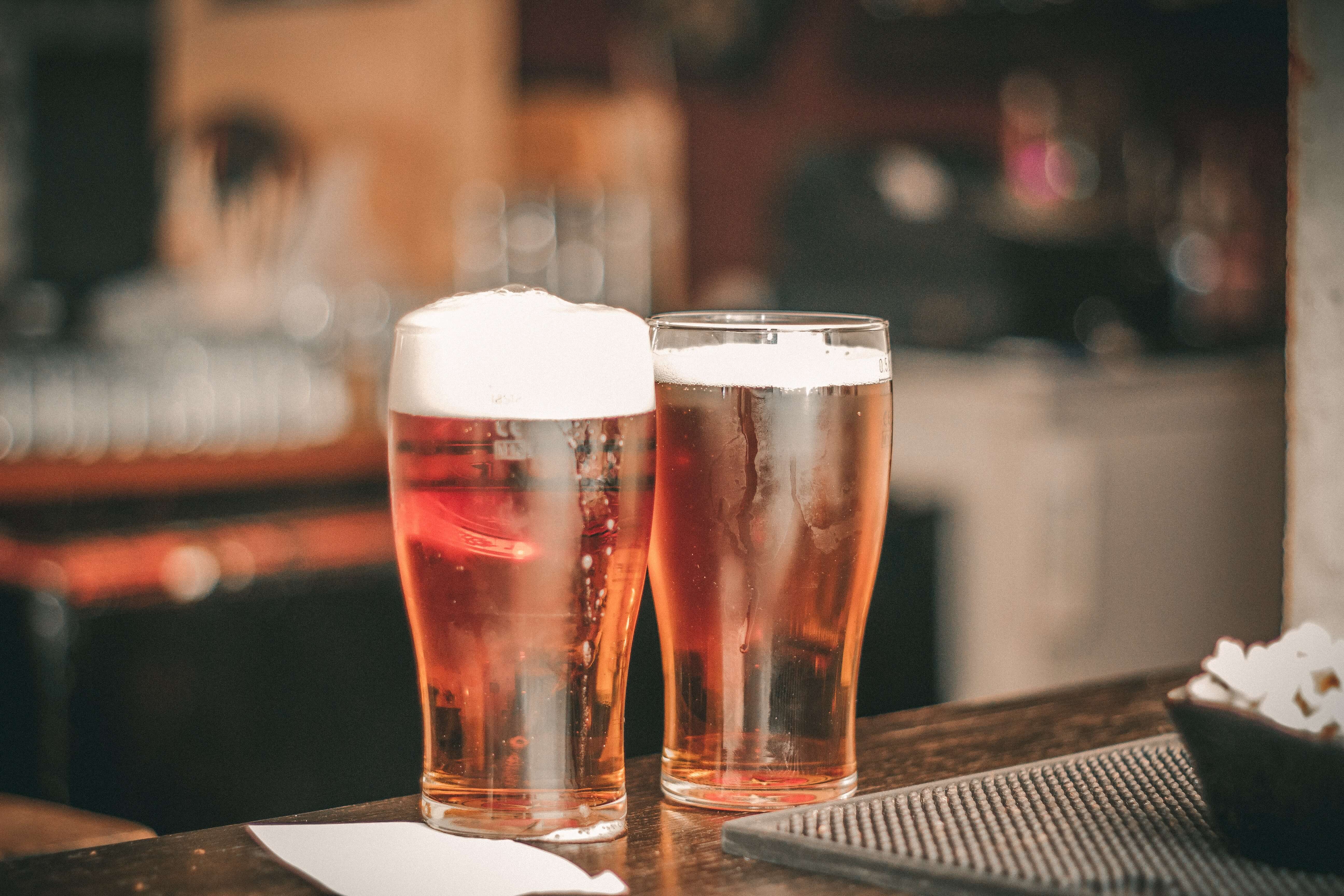
IPA
Infamously developed to ship British ale to India, these beers are hop laden and both highly bitter and highly aromatic, with a higher ABV to match. Especially perfectly served cold on a hot day and pairs well with seafood and spicy dishes.
British IPA
Far less bitter than other IPAs, the original recipe os far more smooth and aromatic, featuring hops like Challenger, Goldings and Fuggles. The style is exemplified by Worthington Whiteshield.
American IPA
tends to mean hoppier than the original, but this is a term rarely used these days.
Session IPA
An IPA with a lower ABV. It is rumoured that the term ‘session beer,’ comes from WWI Britain after the government began to regulate drinking whilst working at the munitions factory. The lower ABV meant that the worker’s alloted drinking ‘sessions’ would be less disruptive the manufacturing process
West coast IPA
Originating from the US west coast, this is an especially dank, resinous, bitter and piney IPA.
East coast IPA
A more recently popularised brew, East Coast IPAs are soft and juicy, with little bitterness
NZPA
New Zealand Pale Ale- IPAs that showcase New Zealand hops; often much fruitier, with mango and peach notes. DIPA
Double IPA: twice the hops and usually double the ABV, more syrupy. Can be opaque. They reflect the character of the IPA they are ‘doubling.’
Black IPA
A mashup of the richly dark malt base of a stout or porter, loaded with IPA hops. Expect caramel, chocolate and coffee as it hits the tongue, exploding into piney, citrus, dank berry notes. Rich, bright. Bitter.
New England IPA
The belle of the ball this season. Dry hopped extensively (or double dry hopped) and also made using some high protein malts to leave more matter in the beer, making it thicker and smoother. Not filtered or pasteurized, leaves much of the hop matter in the beer. Aromatic, flavourful and very hazy. These beers can be deeply dank, very hoppy and bitter, or unexpectedly fruity. They are always cloudy with a funky, green resinous flavour. Often comes in a 16 oz Tallboy.
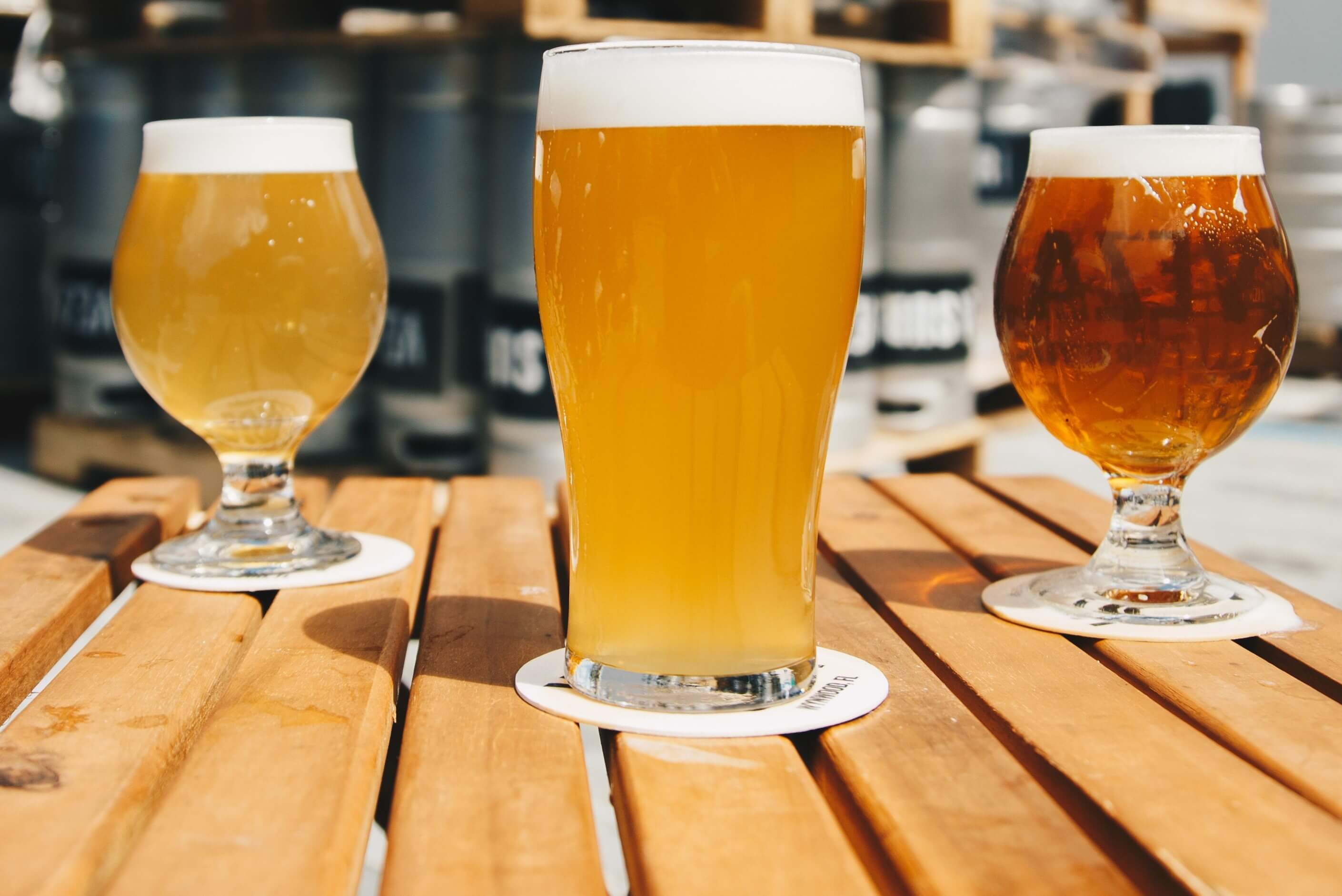
Lager
Bottom fermented, with a cold, long, slow and steady fermentation to create crisp, light flavours. Emphasis is placed on the malts and noble hops. We like to pair Camden Hells craft lager with salted mixed nuts. This category includes; Helles, Vienna Lagers, Bock beers, Kellerbiers, Dunkel, Smoked lager and Strong Lager.
Dunkel and Smoked lager are both dark, but this colour is produced in different ways. Dunkels use decoction mashing of mid roasted Munich malts to gain their brown to black colours. Smoked lager (or Rauchbier) is made by drying out the malts over beechwood fires- the perhaps most popular form being the Schlenkerla rauchbier.
Pilsner
Maltier than a lager, with delicate flavours. Has a straw colour and light body, with more hop character and bitterness than a lager.
Saison
A light and refreshing farmhouse beer. Often described as funky it is very ester heavy, with lots of sediment and yeast left in the bottle. One of the few beers where yeast provides the dominant flavour profile.
Sours
Sour beers are defined by their tart, very dry mouthfeel and often ‘funky’ flavour profile. This descriptor includes Lambic, Gose, Gueuze and Berliner Weisse. As this is one of the most notoriously difficult beer styles to brew, many modern brewers are avoiding meddling with wild yeast strains and adding yoghurts or lactic acids to the beers to achieve the same effect.
Wheat beer
Wheat beers are often thicker than pure barley beers as less of the protein is eaten in the fermentation. Wheat beers are often top-fermented with a golden colour and hazy appearance. Notables styles include Hefeweizen, Dunkelweizen and Witbier.
Eisbock
This is by far a less common beer style as it is the result of a specialised form of beer fortification. The beer is brewed and then frozen. The ice is removed, leaving concentrated beer behind: giving the resultant brew its name. Eisbock’s are very malty and syrupy with low head retention and low carbonation.
Back To Top
Or browse our range of Beer Hampers and Hampers for Him
This blog was posted 2019-07-23 11:24:00 .
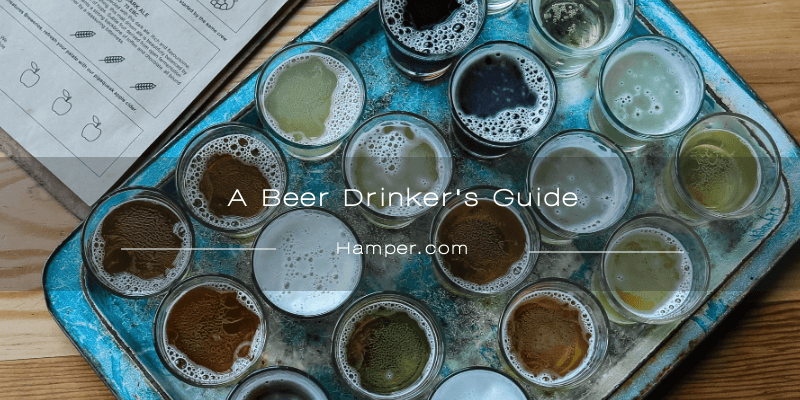
 Hop bines growing vertically up the frame[/caption]
Hop bines growing vertically up the frame[/caption]
 A sea of hops ready to be processed into beer[/caption]
A sea of hops ready to be processed into beer[/caption]
 Sorghum growing in the field[/caption]
Sorghum growing in the field[/caption]
 Huge amounts of malts are moved around the brewery in the malting process[/caption]
Huge amounts of malts are moved around the brewery in the malting process[/caption]
 "In-ground" copper brew kettle[/caption]
"In-ground" copper brew kettle[/caption]
 Brewer checks the level of conditioning[/caption]
Brewer checks the level of conditioning[/caption]
 Craft IPA getting poured into cans[/caption]
Craft IPA getting poured into cans[/caption]















